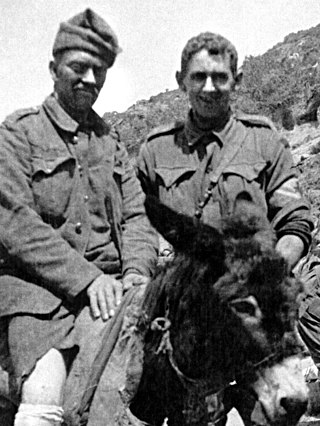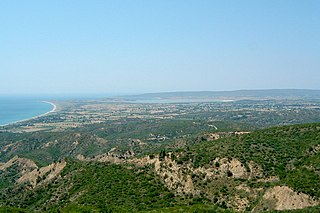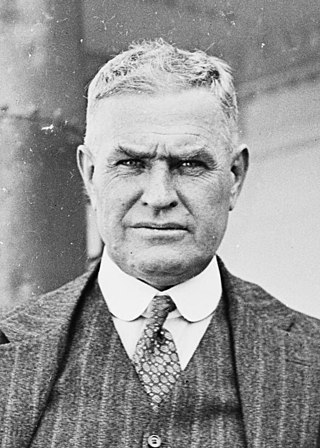
Mel Columcille Gerard Gibson is an American actor and film director. He is known for his action hero roles, particularly his breakout role as Max Rockatansky in the first three films of the post-apocalyptic action series Mad Max and as Martin Riggs in the buddy cop action-comedy film series Lethal Weapon.

The Gallipoli campaign, the Dardanelles campaign, the Defence of Gallipoli or the Battle of Gallipoli was a military campaign in the First World War on the Gallipoli peninsula from 19 February 1915 to 9 January 1916. The Entente powers, Britain, France and the Russian Empire, sought to weaken the Ottoman Empire, one of the Central Powers, by taking control of the Ottoman straits. This would expose the Ottoman capital at Constantinople to bombardment by Entente battleships and cut it off from the Asian part of the empire. With the Ottoman Empire defeated, the Suez Canal would be safe and the Bosphorus and Dardanelles straits would be open to Entente supplies to the Black Sea and warm-water ports in Russia.

The Battle of the Nek was a minor battle that took place on 7 August 1915, during the Gallipoli campaign of World War I. "The Nek" was a narrow stretch of ridge on the Gallipoli Peninsula. The name derives from the Afrikaans word for a "mountain pass" but the terrain itself was a perfect bottleneck and easy to defend, as had been proven during an Ottoman attack in June. It connected Australian and New Zealand trenches on the ridge known as "Russell's Top" to the knoll called "Baby 700" on which the Ottoman defenders were entrenched.

The New Zealand and Australian Division was a composite army division raised for service in the First World War under the command of Major General Alexander Godley. Consisting of several mounted and standard infantry brigades from both New Zealand and Australia, it served in the Gallipoli Campaign between April and December 1915.
The Battle of Sari Bair, also known as the August Offensive, represented the final attempt made by the British in August 1915 to seize control of the Gallipoli peninsula from the Ottoman Empire during the First World War.

The Battle of Chunuk Bair was a World War I battle fought between the Ottoman defenders and troops of the British Empire over control of the peak in August 1915. The capture of Chunuk Bair,, the secondary peak of the Sari Bair range, was one of the two objectives of the Battle of Sari Bair.

The landing at Anzac Cove on Sunday, 25 April 1915, also known as the landing at Gaba Tepe and, to the Turks, as the Arıburnu Battle, was part of the amphibious invasion of the Gallipoli Peninsula by the forces of the British Empire, which began the land phase of the Gallipoli Campaign of the First World War.

John Kirkpatrick, commonly known as John Simpson, was a stretcher bearer with the 3rd Australian Field Ambulance during the Gallipoli campaign – the Allied attempt to capture Constantinople, capital of the Ottoman Empire, during the First World War.

Phillip Davey, was an Australian recipient of the Victoria Cross (VC), the highest award for gallantry in battle that could be awarded to a member of the Australian armed forces at the time. Davey enlisted in the Australian Imperial Force in December 1914 for service in World War I, and joined his unit, the 10th Battalion, on the island of Lemnos on 10 April 1915. Along with his battalion, he landed at Anzac Cove, Gallipoli, on 25 April. He fought at Anzac until he was evacuated sick in early November, returning to Australia the following January.

The landing at Suvla Bay was an amphibious landing made at Suvla on the Aegean coast of the Gallipoli peninsula in the Ottoman Empire as part of the August Offensive, the final British attempt to break the deadlock of the Battle of Gallipoli. The landing, which commenced on the night of 6 August 1915, was intended to support a breakout from the ANZAC sector, five miles (8 km) to the south.

Gallipoli is a 2005 Turkish documentary film written and directed by Tolga Örnek. It is a documentary about the 1915 Gallipoli campaign, narrated by both sides, the Turks on one side and the British soldiers and Anzacs on the other side.

Major General John Macquarie Antill, was a senior Australian Army officer in the New South Wales Mounted Rifles serving in the Second Boer War, and an Australian Army general in the First World War.

Major General Sir Thomas William Glasgow was a senior Australian Army officer and politician. Glasgow rose to prominence during the First World War as a brigade and later divisional commander on the Western Front. Post-war, he was elected to the Australian Senate, representing Queensland as a Nationalist Party member from 1919 to 1931, before appointment as Australian High Commissioner to Canada. In 1945, Glasgow returned to Australia and resumed his private business interests. He died in Brisbane in 1955, at the age of 79.

Major General William Holmes was a senior Australian Army officer during the First World War. He was mortally wounded by a German artillery shell while surveying the ground won at the Battle of Messines.

The Lighthorsemen is a 1987 Australian war film about the men of a World War I light horse unit involved in Sinai and Palestine campaign's 1917 Battle of Beersheeba. The film is based on a true story and most of the characters in the film were based on real people.
Anzacs is a 1985 Australian five-part television miniseries set in World War I. The series follows the lives of a group of young Australian men who enlist in the 8th Battalion (Australia) of the First Australian Imperial Force in 1914, fighting first at Gallipoli in 1915, and then on the Western Front for the remainder of the war.

Percy Charles Herbert Black, was a decorated Australian soldier who served with the Australian Imperial Force in the First World War.

The Wallach brothers were a family of eight boys born to Henry and Mary Wallach of Bondi Beach in Sydney, Australia toward the end of the 19th century. Six of the brothers all saw active service in World War I. The fourth and eighth brothers, Clarrie and Neville were both top-grade rugby union players before the War. They both saw action at Gallipoli, were promoted on the Western Front as Captains, were both recipients of the Military Cross and each fell within a week of each other in France in fighting at the time of the Second Battle of Villers-Bretonneux.

The battle for Baby 700, was an engagement fought during the Gallipoli Campaign of the First World War, between the forces of the British Empire and the Ottoman Empire.

The third attack on Anzac Cove was an engagement during the Gallipoli Campaign of the First World War. The attack was conducted by the forces of the Ottoman Turkish Empire, against the forces of the British Empire defending the cove.


















